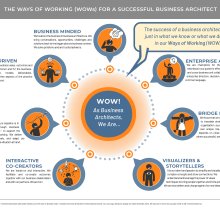Business architecture and the business architect role continue to expand and mature across the globe. There has also been a shift in the way we practice the discipline. Collectively, we are increasingly business-focused, value-oriented and strategically-minded. That means putting the business in business architecture first and remembering that things — like building the architecture knowledgebase and performing governance — are enablers. In other words, business architecture is a means to the end, not an end in itself. But we still have work to do.
As a newer role on the scene, working in a business world ubiquitous with design, digital, agile and other emerging concepts, the way we show up as business architects matters a lot. Because everything we do and say demonstrates to others what business architecture really is, and we need to be relevant and distinguish ourselves. The success of a business architect then is not just in what we know or what we do — but in our Ways of Working (WOWs).
So, let’s explore some key ideas.
In addition to learning the discipline, building a practice and showing value, I also must consider how I work?
Yes. Sometimes it can feel like we’re building an aircraft while in flight. However, showing up in a relevant way that engages others can make all the difference and helps to support and make successful all the effort you are investing. And, it just starts with being deliberate about your mindset, which you can work into over time, and investing where you and your team have growth opportunities.
P.S. More on how to establish a practice (a.k.a building while in flight) in StraightTalk Post No. 4.
Why does this matter?
Simply said, because when we are engaging, relevant and effective in the way that we work, we can get to the right people and at the right tables where we can deliver the value proposition for which business architecture is intended. And we can be invited to participate.
Here are some reasons why this is so important:
- Architecture is already an abstract concept that can seem academic to some people. As a result, we have to overcompensate a bit to gain attention, make friends, and draw people in to try something new when they are already busy with lots of work and other new concepts.
- Architecture teams need to adapt to how the world has evolved and the new expectations that come with it. Smart phones, design-thinking, agile approaches, the digital revolution, and more. People are changing the way they work, and other disciplines and their approaches are gaining traction. As a result, architecture approaches need to adapt too, such as to work in more collaborative and visual ways, and to work at different speeds.
- Effective ways of working are needed to achieve our goals anyway. Ways of working that are engaging to others are the very same ones that help us to effectively do our jobs anyway, such as bringing people together towards a common vision and understanding. Not to mention, they make the job more fun and bring out the best in ourselves!
What has proven to not work very well for enterprise or business architecture teams — especially not for business architecture teams — is the ivory tower (as some call it), if-we-build-the-architecture-repository-they-will-come, waterfall mindset, governance heavy approach. What does work well is serving the business, being a great partner to other teams, and continually delivering value. And yes, the business architecture knowledgebase is critical to delivering on our value proposition, but we always need to remember that it’s an enabler, not the end game. (More on this idea: Speedy Business Architecture, Part 1 — Accelerating Business Architecture Development With Reference Models.)
What are some effective Ways of Working to consider?
Here are a few WOWs as food for thought.
Successful business architects are…
- Value-Driven. What drives us is business value, outcomes and results for the customer (or constituent, patient or your equivalent) and for the business. The architecture, models, deliverables, governance and other aspects of the practice are a means to the end. (More on value: StraightTalk Posts No. 2 and No. 3, and No. 55).
- Business Minded. We’re about the business in business architecture. We bring conversations, opportunities, challenges and solutions back to the bigger picture business context. We solve problems and are trusted advisors.
- Enterprise Advocates. We are champions for the enterprise. We are relentless in our quest for effective strategy execution and cross-business unit collaboration. We care about enterprise direction, decision-making, resources and common language. (Here’s an example: StraightTalk Post No. 64).
- Bridge Builders. We know that we work in an ecosystem of teams to translate strategy into action and run the organization successfully. While we have our own unique role, we know that our success depends on close partnerships and by making others successful, we all succeed. (More on how we work with other teams in Post No. 5 and within a strategy execution context, Post No. 50)
- Visualizers and Storytellers. It is our talent and passion to simplify and visualize complex concepts and show connections. We understand and leverage the power of visual techniques to bring people together and incite action. We are storytellers and change agents for new ideas. (Check out the whole three-part series on visualization, graphic recording and facilitation, and storytelling in Posts No. 46, No. 47 and No. 48.)
- Interactive Co-Creators. We are hands-on and interactive. We facilitate and co-create outcomes together with our business stakeholders and with our partners. We are fun!
- Iterative and Adaptive. Once the business architecture baseline is in place, we build just enough business architecture, just in time to support the business scenario we are solving. We deliver results quickly and iteratively and adapt our approaches and outputs to the situation at hand.
Here is a diagram that summarizes all of this:
Got it. So, where do we go from here?
If you work in a newer business architecture team, you have an opportunity to be deliberate from the very beginning. If you work in an established business architecture team, you may have some shifts to make. Gather your business architecture team and introspect on how you show up now and how you want to show up. Create your own set of business architecture principles or imperatives or WOWs that describe how you act and want to be perceived. Write them down and articulate them such as with a description and some examples that will help you know when you’re meeting them.
But don’t stop there. Stick them up on the wall and look at them every day. Talk about them. Recognize each other when they exemplify them. Hold each other accountable when they don’t. You can even work the ideas into your business architect competency model and training plans. And of course, teach them to new members during onboarding.
This is imperative.
So, there’s your homework, but it’s fun homework. And if we all showed up like this, think about how others would perceive business architecture and the business architect role. A trusted advisor. A valued partner. A career path to aspire to. And most importantly, with effective and relevant ways of working that get us to the right tables, think about how much more impact we could make towards our ultimate goals of creating more successful and competitive organizations with better strategy execution.
More Good Stuff…
Farnam Street Principles (Farnam Street): While we’re on the topic of principles, check out the Farnam Street Five. Great food for thought.
The Ten Golden Rules of Leadership: Classical Wisdom for Modern Leaders (Farnam Street): More wisdom from Farnam Street to take to heart.
Everyday Leadership (TED Talk): A powerful and humorous TED Talk by Drew Dudley that calls on us to celebrate leadership as the everyday act of improving each other’s lives. Because that’s what this is really all about.

